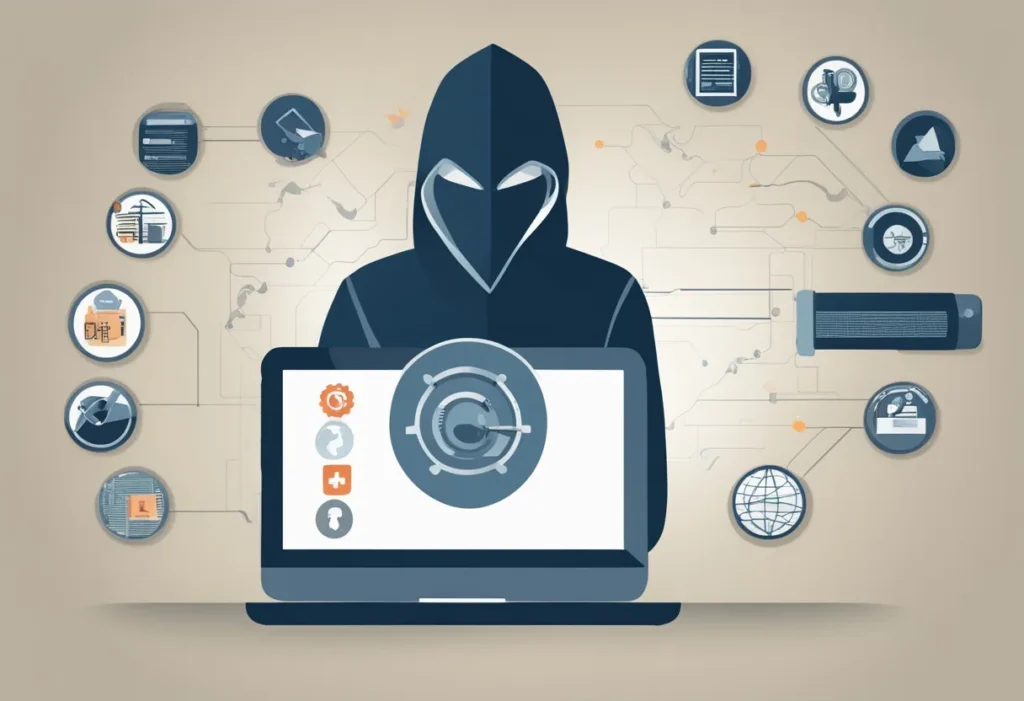The Internet Is a Minefield—Are You Ready?
Common Cyber threats are everywhere. Your data? Targeted. Your bank account? At risk. Your personal info? Probably already leaked somewhere.
It’s not just hackers in hoodies anymore. Cybercriminals operate like businesses—efficient, ruthless, and always evolving.
So, what are the biggest threats lurking online? Let’s break them down.

1. Phishing Scams – The OG of Cyber Attacks
Ever get an email from your ‘bank’ asking you to verify your account? Or a text saying you’ve won a free iPhone?
That’s phishing.
How It Works:
- You get an email, text, or message pretending to be from a legit source.
- It has a sense of urgency: “Click this link now, or your account will be suspended!”
- The link takes you to a fake site where you unknowingly give away your credentials.
Real-World Example:
In 2020, Twitter suffered a phishing attack where hackers tricked employees into revealing internal system credentials. This allowed them to take over high-profile accounts, including Elon Musk and Barack Obama, to run a Bitcoin scam.
How to Avoid It:
- Never click links in emails or texts unless you’re 100% sure.
- Check the sender’s email address. (If it looks off, it probably is.)
- Use a password manager – it won’t autofill your details on fake sites.
✅ Free Tool: Have I Been Pwned – Check if your email has been part of a data breach.
2. Ransomware – Pay Up or Lose Everything
Ransomware is like a digital hostage situation. Hackers lock up your files and demand payment to unlock them.
Who’s At Risk?
- Businesses
- Hospitals
- Individuals with valuable data
How It Works:
- You accidentally download a malicious file.
- Your files get encrypted and you’re asked to pay a ransom (usually in Bitcoin).
- Even if you pay, there’s no guarantee you’ll get your files back.
Real-World Example:
The WannaCry ransomware attack (2017) infected over 230,000 computers worldwide, targeting hospitals, banks, and businesses. It encrypted files and demanded Bitcoin payments, costing billions in damages.
How to Avoid It:
- Backup everything (on an external drive and cloud storage).
- Never download random attachments.
- Use strong, up-to-date antivirus software.
✅ Free Tool: Malwarebytes – Scans and removes malware before it causes damage.
3. Malware – The Silent Killer
Malware = Malicious Software. It can spy on you, steal your data, or turn your device into a zombie for hackers.
Common Types:
- Spyware – Watches everything you do.
- Adware – Floods your screen with annoying pop-ups.
- Trojans – Disguised as legit software but packed with malware.
Real-World Example:
In 2021, Flubot malware spread through Android phones via fake package delivery texts. Once installed, it stole banking details and spread to other devices through SMS.
How to Avoid It:
- Don’t download shady software.
- Keep your operating system updated.
- Use an ad blocker to prevent malicious ads.
✅ Free Tool: Avast Free Antivirus – Protects against malware in real-time.

4. DDoS Attacks – Crashing Websites for Fun and Profit
DDoS (Distributed Denial of Service) attacks flood websites with fake traffic, making them crash.
Who’s Targeted?
- Businesses
- Gaming servers
- Government websites
How It Works:
- Hackers use thousands of infected devices (a botnet) to send massive amounts of traffic to a target website.
- The server gets overwhelmed and crashes.
- This can be done for revenge, blackmail, or just chaos.
Real-World Example:
In 2016, the Mirai botnet attack took down major websites like Twitter, Reddit, and Netflix by launching one of the largest DDoS attacks in history using infected IoT devices (like smart cameras and routers).
How to Avoid It:
- Use a web application firewall (WAF).
- Monitor traffic for unusual spikes.
- Ensure your devices (especially IoT) have strong passwords and updates.
✅ Free Tool: Cloudflare – Protects websites from DDoS attacks.
5. Social Engineering – Hacking People, Not Computers
Social engineering tricks people into revealing confidential information.
Common Tactics:
- Pretexting – Pretending to be someone trustworthy (e.g., IT support).
- Baiting – Leaving infected USB drives in public places.
- Impersonation – Using fake identities to gain access.
Real-World Example:
In 2020, a Twitter employee was manipulated into giving access to internal tools, leading to high-profile account takeovers for a Bitcoin scam.
How to Avoid It:
- Always verify identities before sharing info.
- Be skeptical of urgent requests.
- Educate employees and teams on social engineering tactics.
✅ Free Tool: KnowBe4 – Offers free phishing tests and cybersecurity training.
6. Trojans – Malware in Disguise
A Trojan looks like legit software but contains malicious code.
How It Works:
- You download a file that seems harmless.
- It runs in the background, stealing data or creating backdoors for hackers.
- Often used to spread ransomware or spy on users.
Real-World Example:
The Emotet trojan spread through email attachments and was responsible for billions in damages before being taken down in 2021.
How to Avoid It:
- Only download software from trusted sources.
- Be cautious with email attachments, even from known contacts.
- Use an updated antivirus to scan all downloads.
✅ Free Tool: Bitdefender Free Edition – Detects and removes trojans.
🔥 Pro Tips to Protect Yourself Online
- Use Disposable or Temporary Emails for Sign-Ups – If a website requires an email but you don’t trust it, use a temporary email service like TempMail to avoid spam and potential phishing attempts.
- Use Multi-Factor Authentication (MFA) – Even if someone gets your password, they can’t log in without the second step. Enable MFA on all accounts that support it, especially banking, email, and social media.
- Update Your Software Regularly – Outdated software = easy target for hackers. Always install the latest security updates for your operating system, apps, and browsers. Turn on automatic updates where possible.
- Use a VPN on Public Wi-Fi – Public networks are a hacker’s playground. A Virtual Private Network (VPN) encrypts your connection, keeping your browsing and personal information secure from prying eyes.
- Create Unique Passwords for Every Account – Reusing passwords is like using the same key for your house, car, and office. If one gets stolen, everything is at risk. Use a password manager to generate and store complex passwords securely.
- Check Your Online Accounts for Breaches – Data leaks happen all the time. Use sites like Have I Been Pwned to check if your email or passwords have been compromised and change them if necessary.
- Think Before You Click – If a link looks suspicious, don’t click it. Phishing scams rely on urgency and trickery. Always hover over links to check their actual destination before clicking.
- Backup Important Files – Ransomware-proof your data with regular backups. Store them both in the cloud and on an external hard drive that’s disconnected when not in use.
- Use Strong, Unique Security Questions – Avoid easy-to-guess answers like your mother’s maiden name or pet’s name. Instead, treat security answers like additional passwords—random and unrelated to real life.
- Enable Firewall & Antivirus Protection – A firewall acts as a first line of defense against cyber threats. Pair it with trusted antivirus software to detect and block malware before it causes damage.
- Be Wary of Unsolicited Emails and Messages – Cybercriminals often disguise themselves as banks, service providers, or even friends. If something feels off, verify the sender before taking any action.
- Secure Your Smart Devices (IoT) – Change default passwords on routers, security cameras, and smart home devices. Update their firmware regularly to prevent vulnerabilities.
- Use Encrypted Messaging Apps – If privacy matters to you, use messaging apps like Signal or WhatsApp, which offer end-to-end encryption to protect your conversations.
- Lock Down Your Social Media Privacy Settings – Limit what personal information is visible to the public. Cybercriminals can use social media to gather details for identity theft or targeted attacks.
- Monitor Your Financial Statements Regularly – Check your bank and credit card statements for unauthorized transactions. The sooner you catch fraud, the better you can prevent further damage.
- Be Skeptical of “Too Good to Be True” Offers – Scams promising free money, lottery wins, or high returns on investment are almost always fraudulent. If it sounds too good to be true, it probably is.
- Turn Off Bluetooth & Location When Not in Use – Hackers can exploit open Bluetooth connections and track your location. Disable these settings when you don’t need them.
FAQs
Q: What’s the most common cyber threat?
A: Phishing. It’s easy for hackers, and people fall for it daily.
Q: Can I get hacked just by clicking a link?
A: Yes! Some links auto-download malware the moment you click them.
Q: Is antivirus enough to stay safe?
A: Nope. You also need strong passwords, MFA, and common sense.
Q: What should I do if I get hacked?
A: Change your passwords immediately, scan your device for malware, and monitor your accounts for suspicious activity.
Know More: Cybersecurity for Beginners
Final Thoughts
Common Cyber threats aren’t going anywhere. They’re getting smarter.
But so can you.
Stay sharp. Use the right tools. And never, ever trust a random email offering you a free iPhone.

